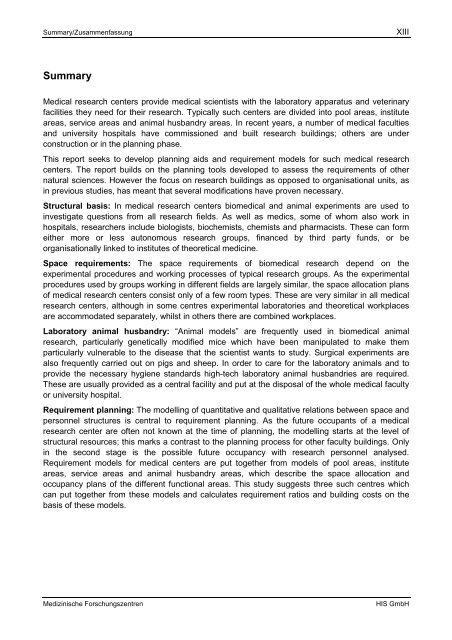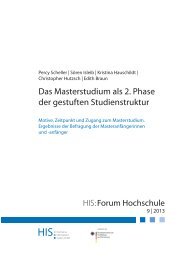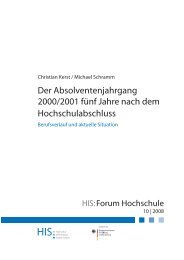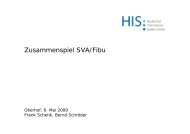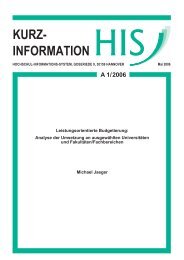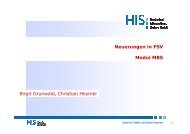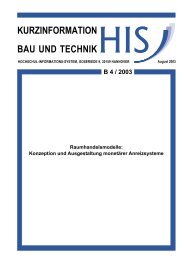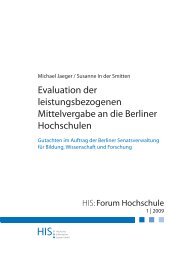PDF-Fassung - Hochschul-Informations-System GmbH
PDF-Fassung - Hochschul-Informations-System GmbH
PDF-Fassung - Hochschul-Informations-System GmbH
- TAGS
- www.his.de
Sie wollen auch ein ePaper? Erhöhen Sie die Reichweite Ihrer Titel.
YUMPU macht aus Druck-PDFs automatisch weboptimierte ePaper, die Google liebt.
Summary/Zusammenfassung XIII<br />
Summary<br />
Medical research centers provide medical scientists with the laboratory apparatus and veterinary<br />
facilities they need for their research. Typically such centers are divided into pool areas, institute<br />
areas, service areas and animal husbandry areas. In recent years, a number of medical faculties<br />
and university hospitals have commissioned and built research buildings; others are under<br />
construction or in the planning phase.<br />
This report seeks to develop planning aids and requirement models for such medical research<br />
centers. The report builds on the planning tools developed to assess the requirements of other<br />
natural sciences. However the focus on research buildings as opposed to organisational units, as<br />
in previous studies, has meant that several modifications have proven necessary.<br />
Structural basis: In medical research centers biomedical and animal experiments are used to<br />
investigate questions from all research fields. As well as medics, some of whom also work in<br />
hospitals, researchers include biologists, biochemists, chemists and pharmacists. These can form<br />
either more or less autonomous research groups, financed by third party funds, or be<br />
organisationally linked to institutes of theoretical medicine.<br />
Space requirements: The space requirements of biomedical research depend on the<br />
experimental procedures and working processes of typical research groups. As the experimental<br />
procedures used by groups working in different fields are largely similar, the space allocation plans<br />
of medical research centers consist only of a few room types. These are very similar in all medical<br />
research centers, although in some centres experimental laboratories and theoretical workplaces<br />
are accommodated separately, whilst in others there are combined workplaces.<br />
Laboratory animal husbandry: “Animal models” are frequently used in biomedical animal<br />
research, particularly genetically modified mice which have been manipulated to make them<br />
particularly vulnerable to the disease that the scientist wants to study. Surgical experiments are<br />
also frequently carried out on pigs and sheep. In order to care for the laboratory animals and to<br />
provide the necessary hygiene standards high-tech laboratory animal husbandries are required.<br />
These are usually provided as a central facility and put at the disposal of the whole medical faculty<br />
or university hospital.<br />
Requirement planning: The modelling of quantitative and qualitative relations between space and<br />
personnel structures is central to requirement planning. As the future occupants of a medical<br />
research center are often not known at the time of planning, the modelling starts at the level of<br />
structural resources; this marks a contrast to the planning process for other faculty buildings. Only<br />
in the second stage is the possible future occupancy with research personnel analysed.<br />
Requirement models for medical centers are put together from models of pool areas, institute<br />
areas, service areas and animal husbandry areas, which describe the space allocation and<br />
occupancy plans of the different functional areas. This study suggests three such centres which<br />
can put together from these models and calculates requirement ratios and building costs on the<br />
basis of these models.<br />
Medizinische Forschungszentren HIS <strong>GmbH</strong>


